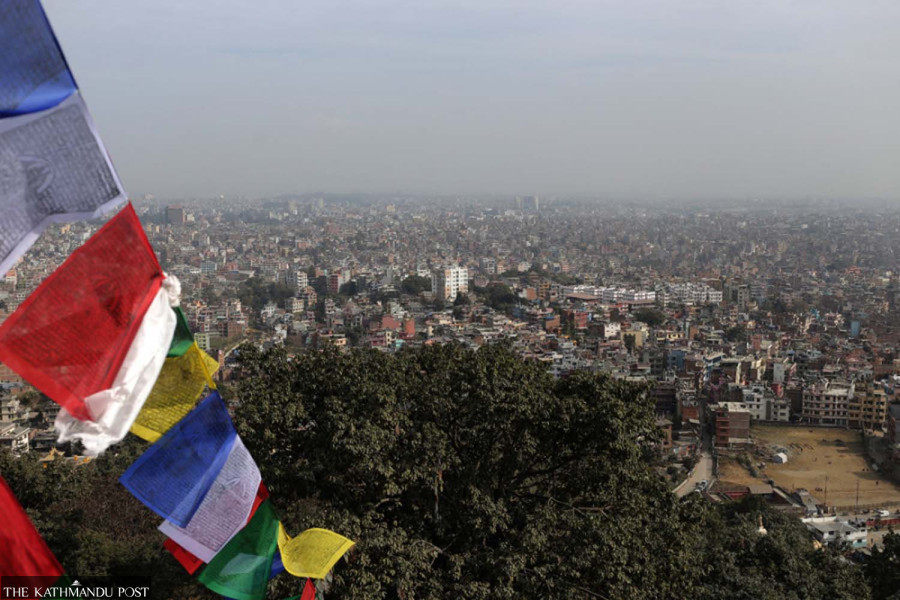Climate & Environment
End of rainy season, stubble burning in India worsen Kathmandu air
Hospitals report rising cases of respiratory illnesses, pollution has risen with the PM2.5 level reaching 137.
Arjun Poudel
After Dashain vacation, the number of patients visiting the Dhumbarahi-based HAMS Hospital with complaints of respiratory illnesses has increased by two-thirds.
Doctors attending patients say besides the elderly with chronic obstructive pulmonary diseases, new patients including children suffering from respiratory illnesses have increased significantly of late.
“People are visiting the hospital in serious conditions,” Dr Raju Pangeni, a consultant pulmonologist at the hospital, told the Post. “Almost daily, we have been shifting three to four patients from the hospital’s emergency ward to the in-patient department.”
Experts blamed the worsening air quality of Kathmandu Valley as the chief culprit behind a sharp increase in respiratory problems. They also said that declining temperatures, onset of the annual flu season, and the ongoing coronavirus pandemic made the problems worse.
Moreover, since the Diwali festival ended last week, the air quality in New Delhi has drastically deteriorated, resulting in an increase in air pollution levels by more than 20 percent compared to the level year ago, which alarmed health as well as environmental experts in Nepal. Also, farmers in Indian states of Punjab and Haryana have started burning the stubbles in the fields, polluting the air, which is transported to neighbouring states and Nepal by winds. Experts said the polluted air has already started entering the country from the west.
Authorities in the capital city of India have suspended construction and demolition activities to combat worsening air quality. But Nepali officials, according to experts, have not taken the pollution seriously or worked out ways to tackle it.
“Although pollution from Delhi may not reach Kathmandu, we should not forget that air quality in Nepal especially in Kathmandu is getting worse,” said Dr Ashesh Dhungana, a pulmonologist at the Bir Hospital. “And, flu season has just started, we have coronavirus too. The worsening air quality could exacerbate the problems.”
Pollution in Kathmandu air has risen with the PM2.5 level reaching 137 on Wednesday from Tuesday’s 129, according to IQAir, the Swiss air quality technology company. The air quality level of Tulsipur, Mid-Western Nepal, reached 161 on Wednesday from 154 on Tuesday.
IQAir collects real-time air-quality data from around the world. PM 2.5 refers to particulate matter or solid and liquid droplets in the air that are less than 2.5 micrometres, or 400th of a millimetre, in diameter.
As per the United States Environment Protection Agency’s air quality index, when PM2.5 reaches 151 to 200 μg/m3, air quality is considered unhealthy; everyone may experience problems, with sensitive groups feeling more severe effects. When it exceeds 300 μg/m3, the level is considered “hazardous” for everyone and may prompt emergency condition alerts.
Doctors say most of the viruses—adenovirus, rhinovirus, and seasonal influenza—get active in the winter season.
According to doctors at the Bir Hospital, around 150 patients suffering from respiratory diseases have been visiting the hospital’s outpatient department and emergency department every day.
Doctors say air pollution is known to cause various respiratory illnesses. Poor air quality can cause short- and long-term effects on public health. Bad air quality can lead to pneumonia, bronchitis, conjunctivitis, skin allergy, stroke, and heart problems in the short term, and ulcers and cancer of the lungs and intestine, kidney disease, and heart problems, in the long run.
Doctors advise people to avoid places that are highly polluted and stay at home. But staying in a closed environment could also increase the risk of respiratory infections including the coronavirus.
“We should not close windows all the time while staying indoors and should wear face masks while going out,” said Pangeni, a consultant pulmonologist. “Maintain social distance, protect yourself from possible infection. The flu vaccine is available in the market and those who can afford, should take one.”
Environmentalists warn that a rise in both pollution levels and cases of respiratory illness is just the beginning, as the worst is yet to come.
"Air pollution starts deteriorating from November and reaches its peak in January every year," said Bhupendra Das, air quality expert at Clean Air Asia, an international non-governmental organisation. "We may not be able to completely prevent the air pollution from getting worse, but we can do certain things to control it."
Experts say preventing open burning, forest fire, burning of agriculture residues, and reducing vehicular emissions are among the things that help in cutting the pollution level. For that awareness plays an important role.
"Just one person avoiding open burning is not enough; everyone should work to discourage others from engaging in activities that cause air pollution," said Bhusan Tuladhar, an environmental expert.
Experts advise people to avoid exposure to pollution, and wear face masks while going out.




 7.12°C Kathmandu
7.12°C Kathmandu











